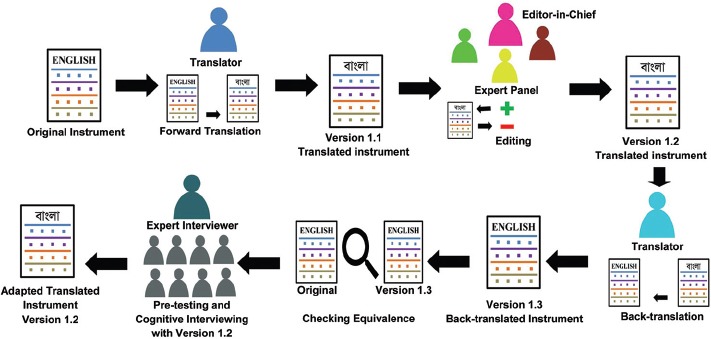Sir,
We read an article contributed by Zieger et al., published in 58th issue of your journal.[1] In the study, authors assessed perception of stigma about mental illness in population of two Indian cities – Kolkata and Chennai and compared the level of stigma among population of these cities. The overall message conveyed through the result of the study is understandable. However, from our viewpoint, the adaptation of translated survey instrument was inadequate, or it was not described in detail. Hence, we intend to share this correspondence with journal readers.
The survey instrument used in the study was originally developed in English. It was translated into local languages and adapted for the study. However, the languages to which instrument was translated were not mentioned. It was necessary because Kolkata and Chennai have a mixed culture with population of different language speakers.[2,3] Detailed linguistic inclusion and exclusion criteria of convenience sample could make the article richer
For the survey, a structured interview was conducted by psychologist. During the interview, changing some words according to the culture, religion, and educational attainment of the sample was a wise decision. However, to get 100% survey response rate, some individuals were asked to redo inaccurate or incomplete input. We wonder how some questionnaires were incomplete. Authors did not use “self-administered” questionnaire. A structured interview is conducted in same order for all participants. It is common that a respondent answer something while she/he is being interviewed. In addition, if some questionnaire were unanswered, it may be due to weakness in the survey instrument itself
The original questionnaire was translated to local language by a private market analysis agency by “back-translation” method. According to our knowledge, back-translation is a part of whole translation method used to adapt an instrument of different language. As shown in Figure 1, translation procedure is depicted briefly according to guidelines by WHO.[4] Among the steps, pretest and cognitive interviewing is vital of all steps.[5] During systemic debriefing of respondents, any flaws in words or phrase are checked. If needed, further modifications of that words or phrase are done to get the final version of questionnaire. Authors did not mention about pretesting of the translated questionnaire. Inadequacy in equivalence between original and translated questionnaire may make the survey a biased one. Hence, authors could include these limitations of their study.
Figure 1.

Pictorial flow chart for translation of an original survey instrument (English) to local language (Bengali) according to the WHO (Key steps: [1] - Forward translation, [2] - expert panel review and editing, [3] - back-translation, [4] - pretesting and cognitive interviewing, [5] - final version)
Correspondence from authors will be highly appreciated.
Financial support and sponsorship
Nil.
Conflicts of interest
There are no conflicts of interest.
REFERENCES
- 1.Zieger A, Mungee A, Schomerus G, Ta TM, Dettling M, Angermeyer MC, et al. Perceived stigma of mental illness: A comparison between two Metropolitan cities in India. Indian J Psychiatry. 2016;58:432–7. doi: 10.4103/0019-5545.196706. [DOI] [PMC free article] [PubMed] [Google Scholar]
- 2.Mukhopadhyay P. Sign Language Decree in Calcutta. BBC News World Edition. [Last accessed on 2017 Mar 20]. Available from: http://www.news.bbc.co.uk/2/hi/south_asia/2654999.stm .
- 3.Report of the Commissioner for Linguistic Minorities. Commissioner for Linguistic Minorities Ministry of Minority Affairs, Government of India. 2011. [Last accessed on 2017 Mar 22]. Available from: http://www.nclm.nic.in/shared/linkimages/NCLM47thReport.pdf .
- 4.WHO. Process of Translation and Adaptation of Instruments. Geneva: WHO; [Last accessed on 2017 Mar 19]. Available from: http://www.who.int/substance_abuse/research_tools/translation/en/ [Google Scholar]
- 5.Hilton CE. The importance of pretesting questionnaires: A field research example of cognitive pretesting the Exercise referral Quality of Life Scale (ER-QLS) Int J Soc Res Methodol. 2017;1:21–34. [Google Scholar]


